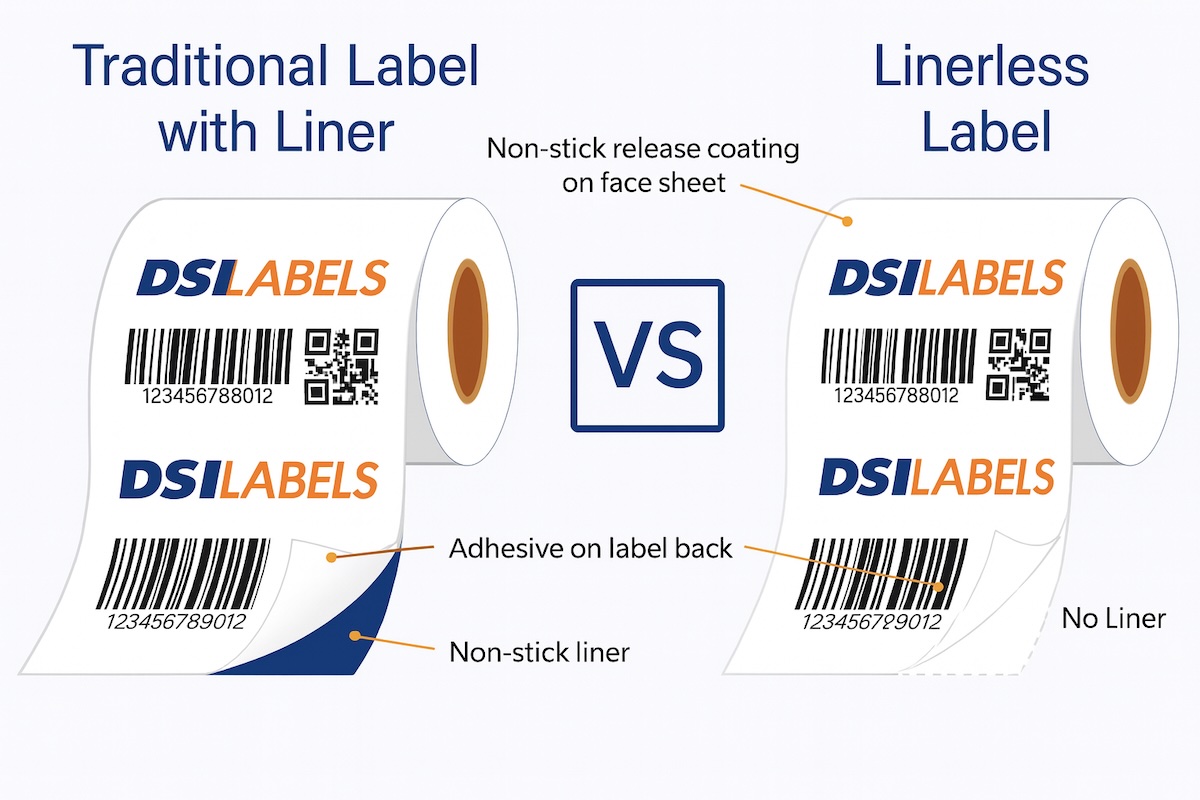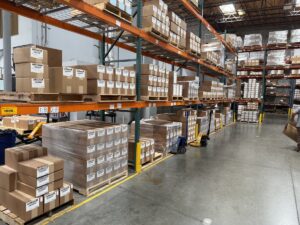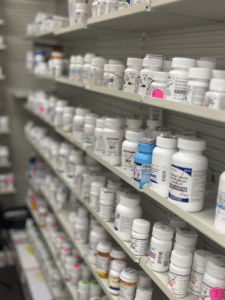Guide to Linerless Labels: Benefits and Applications for Smarter Labeling Solutions
Linerless printing technology is transforming how companies approach their labeling solution needs across various industries. This guide to linerless label systems explains why businesses are making the switch to linerless options and how this eco-friendly innovation delivers measurable results. Whether you’re evaluating desktop and mobile printers or planning your transition to linerless labels, understanding the benefits and applications will help you make an informed decision.
🎧 Listen to this episode of the DSI Labels Podcast:
What Makes Linerless Labels Different from Standard Labels?
A linerless label functions without a liner or backing paper, unlike conventional labels that require peeling from a release liner. These liner-free labels feature a silicone release coating on the top layer of the labels, which prevents the adhesive underneath from bonding to the next label on the roll. The coating on the top layer acts as both a protective barrier and a release mechanism, allowing labels to be wound tightly on rolls while maintaining their ability to peel away from labels underneath when needed.
The adhesive formulation must be compatible with the platen roller in your printer to prevent buildup while ensuring labels stick firmly to products. Traditional label systems waste approximately half their roll space on backing material that goes straight to the landfill after use. Linerless labels eliminate the need for this disposable component entirely, creating a more sustainable labeling solution.
How Do Linerless Printing Solutions Reduce Waste?
Using linerless labels delivers significant environmental impact reduction compared to pressure-sensitive labels. Standard direct thermal labels produce liner waste that cannot be recycled through conventional streams. By adopting a linerless system, businesses prevent this non-recyclable material from reaching landfills while reducing their consumption of fewer raw materials during label manufacturing.
The work environment improves when you reduce waste at the source. Workers no longer handle or dispose of backing paper, eliminating slip hazards from silicone-coated liner accumulation on floors. This operational shift creates safer conditions while demonstrating corporate commitment to sustainability goals.
What Are the Benefits of Linerless Label Printers?
Linerless label rolls contain more labels per roll than standard labels, typically 40-50% more usable material in the same diameter. This increased capacity means fewer roll changes during production shifts, boosting productivity and reducing downtime. A desktop printer equipped for linerless printing can handle variable label lengths without requiring different label size inventory, as labels are printed at the exact length needed for each application.
Companies like Zebra Technologies manufacture specialized linerless printer models designed to manage exposed adhesive safely. These label printers incorporate non-stick platen components and integrated cutters that slice labels cleanly as they’re printed. The transition to linerless labels requires compatible equipment, but the benefits of linerless technology justify the investment for high-volume operations.
Can Any Printer Handle Linerless Media?
Standard labels work in regular thermal printers, but linerless media requires purpose-built equipment. The exposed adhesive on linerless labels will damage conventional printer components, causing jams and deteriorated print quality. You need a linerless printer with special features: a silicone-coated platen roller, an integrated cutting blade, and enhanced maintenance accessibility.
Both desktop printer and mobile printers are available in linerless-compatible versions. Mobile printers benefit particularly from linerless solutions because workers avoid the trailing liner waste that tangles during movement. When implementing linerless systems, verify your equipment specifications carefully to ensure compatibility with your chosen linerless labeling solution.
Where Are Linerless Labels Used Most Effectively?
Linerless labels are versatile across various industries. Food service operations apply labels to food packaging, beverage containers, and takeout orders. Retail environments use them for price marking and inventory tracking. Logistics facilities print shipping labels and packing lists. Healthcare providers create specimen labels and pharmacy bag identifications.
The demand for linerless printing solutions grows strongest in sectors with high label volumes and sustainability mandates. Labels are applied to food products frequently in grocery weighscale applications, where variable label lengths match exactly what each package requires. This flexibility means linerless labels are used efficiently without material waste from oversized or undersized formats.
Does the Switch to Linerless Labels Save Money?
Cost savings emerge from multiple sources when you adopt linerless printing. More labels per roll means reduced shipping costs, as linerless label rolls weigh considerably less than traditional labels with liner backing. Storage requirements shrink proportionally. Disposal expenses disappear when you eliminate the need for liner waste management.
Calculate your return considering label volume, current waste disposal fees, and storage costs. High-volume operations printing thousands of labels daily typically see payback within two years. The productivity gains from fewer interruptions for roll changes add financial value beyond the direct material savings that linerless labels offer.
What Maintenance Do Linerless Label Printers Need?
Linerless printing requires more frequent cleaning than standard labels demand. The special adhesive and silicone release coating system can leave residue on printer components despite being designed to minimize transfer. Platen rollers need regular cleaning, and cutter blades require periodic maintenance to maintain sharp, clean cuts.
Following manufacturer guidelines for maintenance schedules ensures optimal print quality and equipment longevity. While maintenance increases compared to conventional labels operation, the time investment remains manageable and is offset by the elimination of liner disposal tasks. Understanding these requirements before implementing linerless technology helps set realistic operational expectations.
How Difficult Is Adopting a Linerless Labeling Solution?
The transition to linerless labels involves equipment investment, staff training, and workflow adjustment. Workers must learn proper loading techniques and maintenance procedures. Testing your specific application ensures the adhesive bonds adequately to your packaging materials and that printed barcodes scan reliably.
Successful implementation starts with consulting your label supplier about compatible linerless media for your needs. Run pilot programs before full deployment. Train operators thoroughly on the differences between using linerless labels and traditional label systems. Plan for a learning period where productivity may temporarily decrease as teams adapt to new printing solutions.
Are Linerless Labels Truly Eco-Friendly?
Yes, linerless labels reduce environmental impact measurably. They consume fewer raw materials during production since label liners aren’t manufactured. Transportation emissions decrease due to lighter shipping weights. The elimination of liner waste prevents thousands of tons of non-recyclable material from entering waste streams annually.
Beyond waste reduction, the release coating on the top provides UV and moisture protection, extending label life and reducing failures that require reprinting. This durability means labels can also deliver better long-term performance than some traditional label options, further reducing resource consumption from replacement labels.
What Limitations Should You Consider?
Labels come in rectangular shapes only with current linerless technology, as the cutting mechanism relies on straight cuts. Intricate die-cut shapes aren’t possible. Batch printing presents handling challenges since printed labels have exposed adhesive. Operations requiring advance label printing may find linerless systems less suitable than applications where labels are printed and immediately applied.
Temperature sensitivity affects adhesive performance. Storage conditions matter more for linerless label rolls than for standard labels with protective liners. The adhesive chemistry can change if media sits too long or experiences temperature extremes. These factors require attention to inventory rotation and environmental controls.
Key Takeaways:
- Linerless labels eliminate backing paper waste, containing 40-50% more labels per roll than standard labels
- Environmental benefits include reduced landfill waste, lower shipping costs, and decreased raw material consumption
- Specialized linerless printers are required; standard thermal printers cannot handle exposed adhesive safely
- Cost savings come from increased labels per roll, reduced disposal fees, and improved productivity
- Common applications span food service, retail, logistics, and healthcare sectors
- Maintenance requirements increase compared to conventional labels but remain manageable
- Shape limitations restrict linerless labels to rectangular formats only
- The switch to linerless delivers strongest returns for high-volume operations with sustainability goals
- Proper training and compatible equipment are essential for successful implementation
Contact DSI Labels at 714-505-1270 to discuss your linerless labeling requirements with our technical experts.





